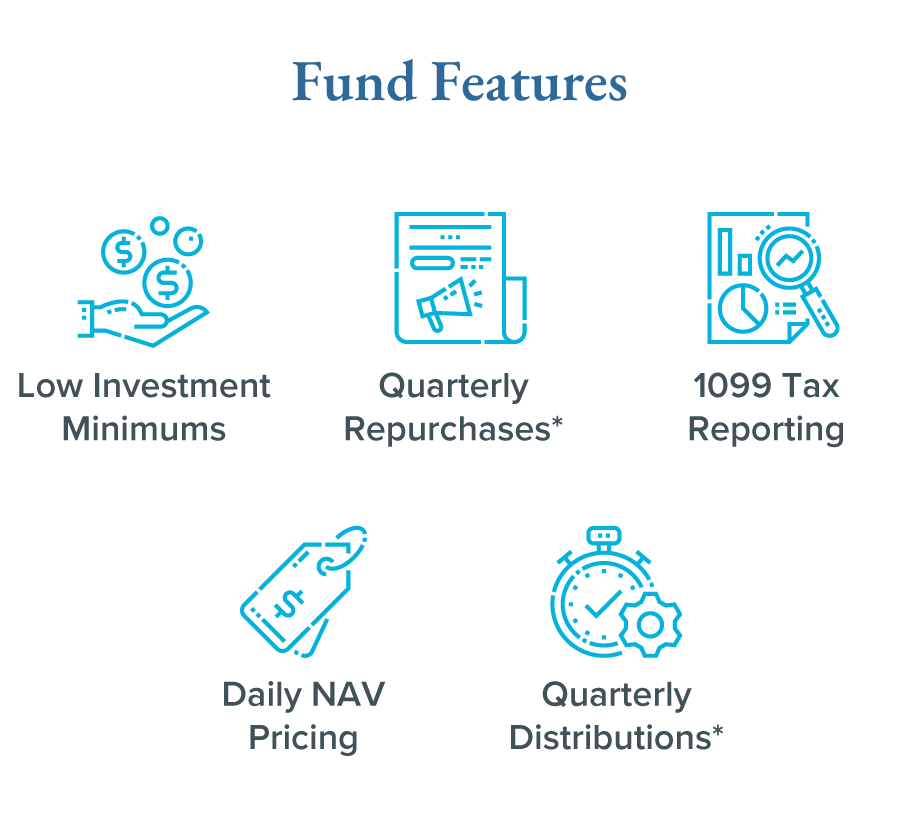Ellington Income
Opportunities Fund
About the Fund
The Ellington Income Opportunities Fund is a continuously offered, non-diversified, closed-end investment management company operating as an interval fund. The Fund seeks to capitalize on the broad opportunity set spanning mortgage, real estate, consumer credit, and corporate sectors in both the public and private markets.
Serving as the Fund’s Sub-advisor, Ellington Global Asset Management, LLC (“Ellington”) is an experienced institutional investment manager that takes a dynamic approach to fixed income investing, attempting to provide high cash flow and attractive risk-adjusted returns throughout the credit cycle.
A comprehensive alternative credit solution for individual investors
Opportunistic Credit Strategy
Broad investable universe includes structured
credit and other non-traditional credit sectors
Experienced Institutional Manager
Invest behind the power of a distinguished global
credit investing platform
Accessible Fund Structure
Access to an institutional credit strategy through
an interval fund structure
Total Return Objective
The fund seeks total return through both current
income and capital gains
Why allocate to alternative credit?
Enhanced Return Potential
Assets are less liquid and more complex than traditional credit assets, providing opportunities to exploit market inefficiencies.
Diversification
Assets are relatively less correlated to equities than traditional liquid credit assets, offering the potential for greater diversification*.
*Diversification does not assure a profit or prevent loss in a declining market.
Why an interval fund?
As a type of closed-end fund, interval funds are accessible to individual investors and offer many investor-friendly features.
Interval funds periodically offer to repurchase a limited percentage of outstanding shares from shareholders, rather than allowing investors to withdraw funds on a daily basis.
This limited and known liquidity profile allows portfolio managers to pursue less liquid, more complex investments that may offer the potential for enhanced returns.

*Distributions and repurchase offers are not guaranteed
Why Ellington?
Founded in 1994, Ellington has one of the longest histories of structured credit investing in the alternative asset management industry and has navigated multiple credit cycles.
Ellington is a global credit manager with offerings ranging from hedge funds, customized separate accounts, private funds and two permanent capital vehicles.
Assets Under
Management1
Old Greenwich, CT
New York and London
own the
firm2
experience of senior
portfolio management
Strengths & Capabilities
Integrated proprietary loan-level
credit modeling framework and
information infrastructure
Deep network of sector-specific
relationships improves access to
deal flow and privately negotiated
transactions
Strong reputation as a reliable
source of capital within small and
inefficient markets
1 As of December 31, 2023, $10.3 billion AUM includes approximately $0.7 billion of Ellington-sponsored CLO equity and notes. Ellington-sponsored CLO AUM includes the face amount of CLO notes and market value of CLO equity, excluding amounts of notes and equity held by other Ellington-managed funds and accounts. AUM includes uncalled capital commitments, if any, and accounts that hold solely loans.
2 Does not include partners formerly employed by Ellington who may have residual capital balances but who no longer have voting rights in the partnership.
Portfolio Managers

Michael Vranos
Mr. Vranos founded Ellington in 1994 to capitalize on distressed conditions in the MBS derivatives market. Mr. Vranos began his Wall Street career in 1983, after graduating magna cum laude, Phi Beta Kappa with a Bachelor of Arts in Mathematics from Harvard University.

Mark Tecotzky
Mr. Tecotzky is a Partner, Managing Director, and head manager for all MBS/ABS credit. Prior to joining Ellington, Mr. Tecotzky was the senior trader in the mortgage department at Credit Suisse. Mr. Tecotzky holds a B.S. from Yale University and received a National Science Foundation fellowship to study at MIT.
Fund Strategy
Investment objective is to seek total return, including capital gains and current income.
Broad Opportunity Set
Opportunistic strategy to pursue value and current income across various types of mortgage, consumer, and corporate-related credit.
Potential for investors with concentrated corporate
credit exposure to diversify credit risk within their
fixed income portfolios.
Less Liquid Assets
Majority of investments will be in assets that are not publicly traded, or that otherwise have less liquidity than exchange-traded securities.
Opportunity to potentially exploit inefficiencies
in smaller, more complex, and less liquid corners
of the credit market.
TARGET ASSETS
Structured
Credit
- Non-Agency RMBS
- CMBS
- CLOs
- Consumer ABS
Opportunistic
Credit
- Consumer loans
- Residentials NPLs and RPLs
- Syndicated loans
Corporate
Securities
- Distressed debt
- High yield bonds
- CDS
Mortgage & Housing
Equities
- Equities of REITs, loan originators, loan servicers
Performance
As of March 31, 2024
| Performance1 | 1 Month | Quarter to Date | Year to Date | 1 Year | 5 Year | Since Inception2 |
|---|---|---|---|---|---|---|
| Class M | 1.17% | 4.26% | 4.26% | 19.48% | 5.04% | 5.19% |
| Bloomberg U.S. Corporate High Yield Index | 1.18% | 1.47% | 1.47% | 11.15% | 4.20% | 4.69% |
| Bloomberg U.S. Aggregate Bond Index | 0.92% | -0.78% | -0.78% | 1.70% | 0.36% | 1.31% |
1 The performance data quoted here represents past performance. Current performance may be lower or higher than the performance data quoted above. Investment return and principal value will fluctuate so that shares, when redeemed may be worth more or less than their original cost. Past performance is no guarantee of future results.
2 Inception date for the M share class is 11/13/2018.
| Performance1 | 1 Month | Quarter to Date | Year to Date | 1 Year | 5 Year | Since Inception2 |
|---|---|---|---|---|---|---|
| Class A (Without Sales Load) | 1.24% | 4.17% | 4.17% | 18.83% | n/a | 3.75% |
| Class A (With Sales Load) | -4.58% | -1.82% | -1.82% | 12.00% | n/a | 2.33% |
| Bloomberg U.S. Corporate High Yield Index | 1.18% | 1.47% | 1.47% | 11.15% | 4.20% | 3.53% |
| Bloomberg U.S. Aggregate Bond Index | 0.92% | -0.78% | -0.78% | 1.70% | 0.36% | -0.81% |
1 The performance data quoted here represents past performance. Current performance may be lower or higher than the performance data quoted above. Investment return and principal value will fluctuate so that shares, when redeemed may be worth more or less than their original cost. Past performance is no guarantee of future results.
2 Inception date for the A share class is 12/16/2019.
| Risk Statistics1 | Standard Deviation2 | Sharpe Ratio3 | Max Drawdown4 |
|---|---|---|---|
| Class M | 7.97% | 0.41 | -15.69% |
| Bloomberg U.S. Corporate High Yield Index | 9.30% | 0.33 | -14.74% |
| Bloomberg U.S. Aggregate Bond Index | 6.06% | -0.13 | -17.18% |
1 All risk statistics are calculated using monthly return series over the period 12/1/18 - 3/31/2024.
2 Standard deviation is a statistical measure of how consistent returns are over time. It is calculated as the square root of variance by determining the variation between each data point relative to the mean. A lower standard deviation indicates historically less volatility.
3 Sharpe ratio is the average return earned in excess of the risk-free rate per unit of volatility. The Auction Average 3-Month U.S. Treasury Bill Rate is used to represent the risk-free rate. Generally, the greater the value of the Sharpe ratio, the more attractive the risk-adjusted return.
4 Max drawdown is the maximum loss from a peak to a trough of a portfolio, before a new peak is attained.
| Risk Statistics1 | Standard Deviation2 | Sharpe Ratio3 | Max Drawdown4 |
|---|---|---|---|
| Class A | 8.83% | 0.22 | -15.66% |
| Bloomberg U.S. Corporate High Yield Index | 10.02% | 0.17 | -14.74% |
| Bloomberg U.S. Aggregate Bond Index | 6.45% | -0.44 | -17.18% |
1 All risk statistics are calculated using monthly return series over the period 1/1/2020 - 3/31/2024.
2 Standard deviation is a statistical measure of how consistent returns are over time. It is calculated as the square root of variance by determining the variation between each data point relative to the mean. A lower standard deviation indicates historically less volatility.
3 Sharpe ratio is the average return earned in excess of the risk-free rate per unit of volatility. The Auction Average 3-Month U.S. Treasury Bill Rate is used to represent the risk-free rate. Generally, the greater the value of the Sharpe ratio, the more attractive the risk-adjusted return.
4 Max drawdown is the maximum loss from a peak to a trough of a portfolio, before a new peak is attained.
Distributions1
1 Distribution rates are not performance and are calculated by summing the quarterly distributions per share over the prior four quarters and dividing by the NAV as of the latest quarter-end. Distributions may be comprised of ordinary income, net capital gains, and/or a return of capital (ROC) of your investment in the fund. Because the distribution rate may include a ROC, it should not be confused with yield or income. A negative value for Undistributed Net Investment Income represents the potential for a ROC on an estimated tax basis. Please refer to the most recent Section 19 Notice, if applicable, for additional information regarding the composition of distributions. Final determination of a distribution’s tax character will be made on Form 1099 DIV sent to shareholders each January.
2 Data does not include special cash dividends.
3 Data is based on distributions since the most recent calendar year-end and does not include special cash dividends.
Distributions1
1 Distribution rates are not performance and are calculated by summing the quarterly distributions per share over the prior four quarters and dividing by the NAV as of the latest quarter-end. Distributions may be comprised of ordinary income, net capital gains, and/or a return of capital (ROC) of your investment in the fund. Because the distribution rate may include a ROC, it should not be confused with yield or income. A negative value for Undistributed Net Investment Income represents the potential for a ROC on an estimated tax basis. Please refer to the most recent Section 19 Notice, if applicable, for additional information regarding the composition of distributions. Final determination of a distribution’s tax character will be made on Form 1099 DIV sent to shareholders each January.
2 Data does not include special cash dividends.
3 Data is based on distributions since the most recent calendar year-end and does not include special cash dividends.
Fund Facts
| Fact | Value |
|---|---|
| Adviser | Princeton Fund Advisors, LLC |
| Sub-Adviser | Ellington Global Asset Management, LLC |
| Structure | 1933 & 1940 Act registered continuously offered closed-end interval fund |
| Liquidity | Quarterly; minimum 5% of Fund NAV1 |
| Distributions | Quarterly |
| Inception Date | November 13, 2018 |
| Custodian | U.S. Bank National Association |
| Independant Auditor | RSM US, LLP |
| Distributor | Foreside Fund Services, LLC |
| Transfer Agent / Admin | US Bank Fund Services, LLC |
1 Please reference the Prospectus for further repurchase offer details.
About the Adviser
Princeton Fund Advisors, LLC (“PFA”) together with its affiliates manage approximately $3.0 billion of assets, as of 12/31/2023 and is a Registered Investment Adviser with the SEC.
The firm’s Investment Committee members contribute more than 60 years of alternative asset management experience to the portfolio management process. PFA serves as the Adviser to the Fund and is responsible for the selection of Ellington Global Asset Management as the Fund’s Sub-Adviser, the ongoing due diligence review of Ellington and the ongoing monitoring of Ellington’s performance on behalf of the Fund. PFA is also responsible for the oversight of the Fund and assuring that investments are made according to the Fund’s investment objective, policies, and restrictions.
Fund Material
Regulatory Documents:
Literature:
Offering:
